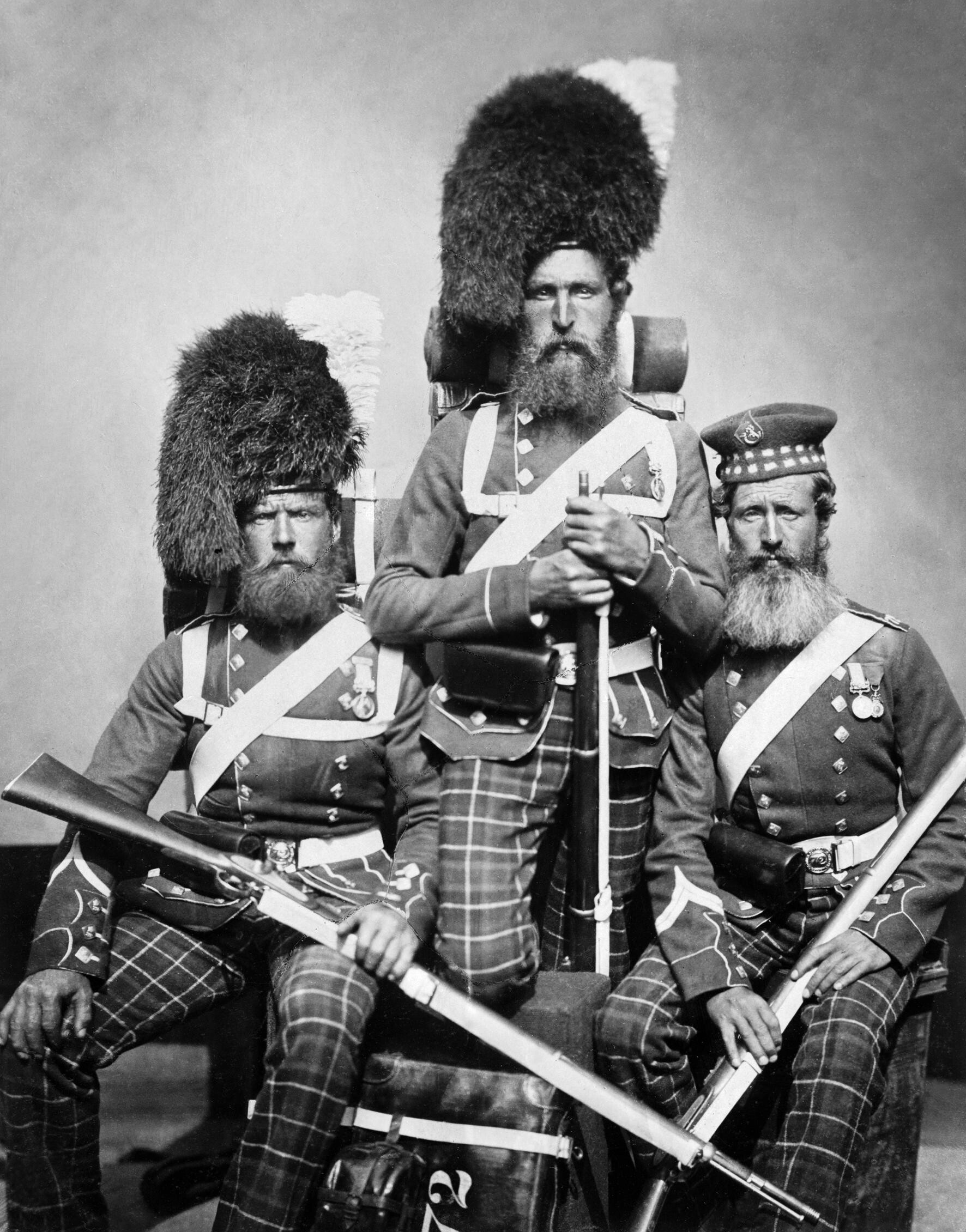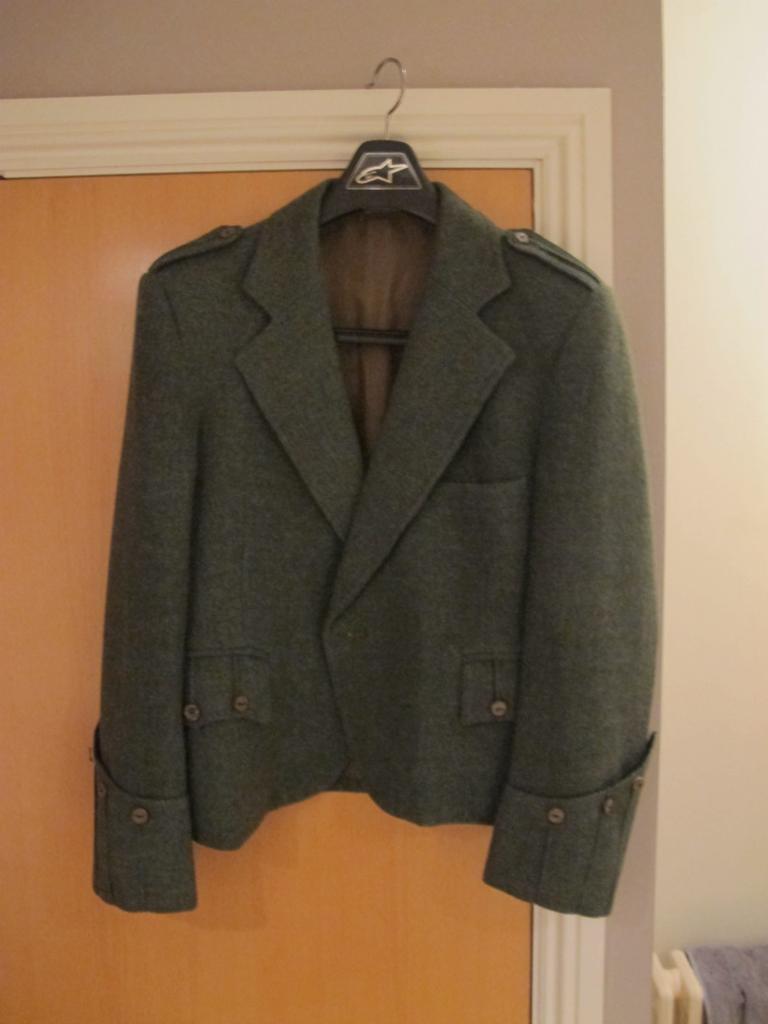|
-
26th December 14, 06:55 AM
#1
Cuffs on traditional Highland jackets
There's a thread on the Contemporary forum discussing the various cuffs seen on traditional Highland jackets, and I thought my reply there might as well (or better) be its own little thread here.
I don't know if contemporary Highland Dress-wearers think of it in these terms, but the various cuffs are the modern descendants of 18th century cuff styles, found on both military and civilian jackets then, both Highland and non-Highland.
One style is usually called, when speaking of uniforms, a 'slash' cuff. It's the sort usually seen on Prince Charlies, but also on the US Marines' Dress Blues jacket, and many other uniforms over the last 300 years or so.
Going way back, early clothing recovered from peat bogs included this style of jacket with form-fitting sleeves which were buttoned all the way up

Coming forward to the Middle Ages, Renaissance, and up to the 17th century one would encounter jackets with sleeves too tight to fit the hand through (whether for warmness, or for fashion) and thus the sleeves had to be buttoned at the bottom

Move to the 18th century and it had evolved into an elaborate cuff, though still capable of being unbuttoned

and by the 19th century had shrunk somewhat, to this

and on 20th century Scottish jackets came to look like this

but is widely seen on non-Scottish uniforms too

The other style is usually called, when speaking of uniforms, a 'gauntlet' cuff.
It too was originally a functional cuff; in cold weather you could unbutton the cuff and lengthen the sleeve. Here is an 18th century jacket on which the sleeves are still fully functional

but in the 19th century had evolved, with Scottish jackets, to this

and by the 20th century looked like this, on civilian jackets

I find it interesting that with Highland jackets the back of the gauntlet cuff began to be made to come up to a point, a feature AFAIK not seen in non-Highland contexts, and on all fours with Highland spats. In non-Highland uniforms the cuffs stayed round, that is, straight across the back with no point, as in early German uniforms (don't get your dander up, this uniform is from before you-know-who came to power)

A current problem with Highland jackets is that various makers call their jackets with these two cuff styles (slash and gauntlet) various things, using the terms Argyll, Braemar, and Crail more or less randomly.
Last edited by OC Richard; 5th January 15 at 07:07 PM.
Proud Mountaineer from the Highlands of West Virginia; son of the Revolution and Civil War; first Europeans on the Guyandotte
-
The Following 10 Users say 'Aye' to OC Richard For This Useful Post:
-
26th December 14, 09:00 AM
#2
Related to gautlet cuffs are what I heard called Polish or cavalry cuff, which I have on my mess jacket. The point appears to be sharper and there is no piping. Since the picture below was taken, I have removed the cuff buttons because they seemed out of place.

I've been thinking lately that I would like to get a tweed kilt jacket with Polish/cavalry cuffs... or even gautlet cuffs without the buttons. Has anyone ever seen such a thing?
- Justitia et fortitudo invincibilia sunt
- An t'arm breac dearg
-
-
26th December 14, 11:28 AM
#3
The old US Army M65 field jacket had gauntlet cuffs, only the gauntlet portion was turned to the inside and not to the outside. Maybe older soldiers will remember this. The pointy gauntlet portion could be folded out and it covered the back of the hand, and was, for me anyway, a nice feature when working bare handed, or with only light gloves on it windy cold weather conditions. It really worked to keep my hands warm. Most guys thought it looked silly, and never used the gauntlet feature. But when the wind chill is 60-below, I sure did. I've always assumed the gauntlet cuff we here associate with Highland dress originated as something functional that could be folded down over the back of the hand and used to keep the wearer warmer. Remember, even the finest of homes in the 17th century were cold drafty places in winter -- and then there was the out of doors. I believe the gauntlets are pointed because on a truly functional cuff. you'd want the underside to only reach the wrist, right behind the palm of the hand, and the back portion to fold down over the back of the hand to fully cover the fingers to the first knuckle. A cuff designed to function in this way, would in it's simplest most easy to construct form would be pointed. It would help keep the wearer warm, and still leave the hand free for work. My beef with "traditional" kilt jackets today is that the gauntlet is just a useless patch of cloth sewn on to create an illusion. It's a mere vestage. A sham. If I were to have made a kilt jacket with gauntlet cuffs, I'd have the gaunlet portion made to be as functional as I believe the earlier versions to have been.
Last edited by Benning Boy; 26th December 14 at 11:29 AM.
-
The Following 2 Users say 'Aye' to Benning Boy For This Useful Post:
-
26th December 14, 11:46 AM
#4
Wow what a great thread full of information on how these cuffs have evolved. I had heard that the buttons on the cuffs were so that the average rank and file soldiers wouldn't wipe their snottery noses with the cuffs of their jackets. Any truth to that one or more urban legend?
Regards David
-
-
26th December 14, 12:20 PM
#5
 Originally Posted by David Dubh

Wow what a great thread full of information on how these cuffs have evolved. I had heard that the buttons on the cuffs were so that the average rank and file soldiers wouldn't wipe their snottery noses with the cuffs of their jackets. Any truth to that one or more urban legend?
Regards David
I have heard that about the cuffs, also, but I don't know if it's historical or legendary.
Wonderful information, Richard, as always. Thanks.
Allen Sinclair, FSAScot
Eastern Region Vice President
North Carolina Commissioner
Clan Sinclair Association (USA)
-
-
26th December 14, 01:00 PM
#6
Midshipmen in the Royal Navy are known as "snotties" and their uniform had three buttons around their jacket cuffs. I think therefore, there is an element of historical truth in the story.
My argyll cuffs can be folded down if required, however in the normal position, I often store small envelopes for posting, bits of paper and even a handkerchief there on occasion.
Last edited by Jock Scot; 27th December 14 at 04:29 AM.
Reason: Typo------changed an S for a D
" Rules are for the guidance of wise men and the adherence of idle minds and minor tyrants". Field Marshal Lord Slim.
-
The Following User Says 'Aye' to Jock Scot For This Useful Post:
-
26th December 14, 02:44 PM
#7
 Originally Posted by David Dubh

I had heard that the buttons on the cuffs were so that the average rank and file soldiers wouldn't wipe their snottery noses with the cuffs of their jackets. Any truth to that one or more urban legend?
Regards David
A problem with that tale is that officer's uniforms also had cuff buttons. Here is the then Captain Horation Nelson painted in 1781:

And this Naval officers full dress coat of circa 1909-10 retains the three buttons:

Last edited by Bruce Scott; 26th December 14 at 02:51 PM.
-
-
27th December 14, 07:12 PM
#8
 Originally Posted by David Dubh

I had heard that the buttons on the cuffs were so that the average rank and file soldiers wouldn't wipe their snottery noses with the cuffs of their jackets.
The buttons were on the cuffs to fasten them shut, originally, because they were functional (that is, could be opened or closed). It's a constant thing in the evolution of military uniforms, functional things becoming merely decorative (and oftentimes then disappearing altogether, because sooner or later Form Follows Function).
Proud Mountaineer from the Highlands of West Virginia; son of the Revolution and Civil War; first Europeans on the Guyandotte
-
The Following User Says 'Aye' to OC Richard For This Useful Post:
-
30th December 14, 05:24 AM
#9
An excellent and informative thread, as always, Richard.
Personally speaking, I have always preferred the gauntlet cuff.
Orionson
"I seek not to follow in the footsteps of the men of old.
I seek the things they sought." ~ Basho
-
The Following User Says 'Aye' to Orionson For This Useful Post:
-
3rd January 15, 08:42 AM
#10
 Originally Posted by OC Richard

The buttons were on the cuffs to fasten them shut, originally, because they were functional (that is, could be opened or closed). It's a constant thing in the evolution of military uniforms, functional things becoming merely decorative (and oftentimes then disappearing altogether, because sooner or later Form Follows Function).
So, BenningBoy has explained the functionality of the gauntlet cuff. What wouldbethe function of the slash-type CUFF?
-
 Posting Permissions
Posting Permissions
- You may not post new threads
- You may not post replies
- You may not post attachments
- You may not edit your posts
-
Forum Rules
|
|

































Bookmarks